We’re standing on the afterdeck, kitted out in full diving gear, ready to jump overboard. Below us are around 30 Caribbean reef sharks and 10 lemon sharks, with indications that the first tiger sharks are also on their way. We look at each other indecisively; are we really going through with this? We count down: 3, 2, 1, GO, and we jump into the water, plunging between the sharks, straight to the bottom. We look around anxiously, nervous about what is going to happen. Everyone back at home has told us we’re mad. Diving with sharks? You’re risking your life!
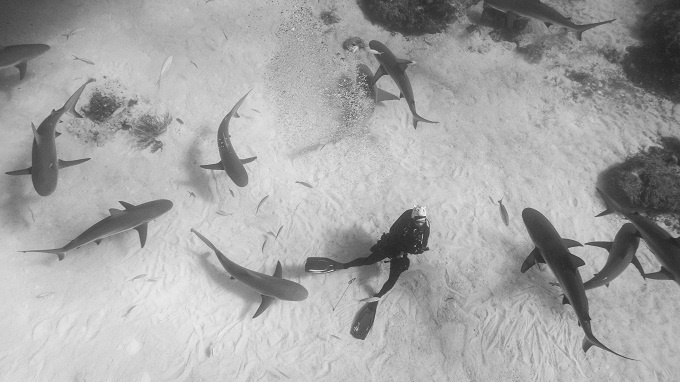
Karin Brussard • OM-D E-M1 MarkII • M.Zuiko Digital ED 12mm F2.0
• PT-EP14 • PPO-EP02
The aim of the trip is to find lemon sharks, reef sharks, tiger sharks and – with a bit of luck – dolphins and great hammerhead sharks. We’re spending five days diving three or four times a day off Tiger Beach, a sandbank no more than 15 metres deep to the north-west of the Grand Bahama island. Our boat is anchored there, trailing several crates containing fish remains. The currents carry the smell from the crates for huge distances, encouraging the sharks to converge on our location. This process – known as chumming – has been used here for many years and practically guarantees the presence of sharks. Twice a day, we get to watch while the sharks are fed underwater. I always used to be fiercely opposed to feeding because I thought it would influence how the sharks behave. After this trip, I’ve come to the conclusion that very little food is actually given; more like a dog getting a treat for coming when his master calls him. The sharks still have to hunt for their own food. So, do they behave differently around us here than elsewhere? Yes, absolutely! They approach us inquisitively to see if we have any treats for them. When they realise we don’t, they swim elegantly past us towards the next diver. I’ve now seen for myself that the way they behave doesn’t really change. So, is feeding them actually necessary? In this case, I think it is. It’s the only way to photograph these sharks and show the rest of the world what magnificent, beautiful creatures they are. And that’s what I want to achieve with my photos.
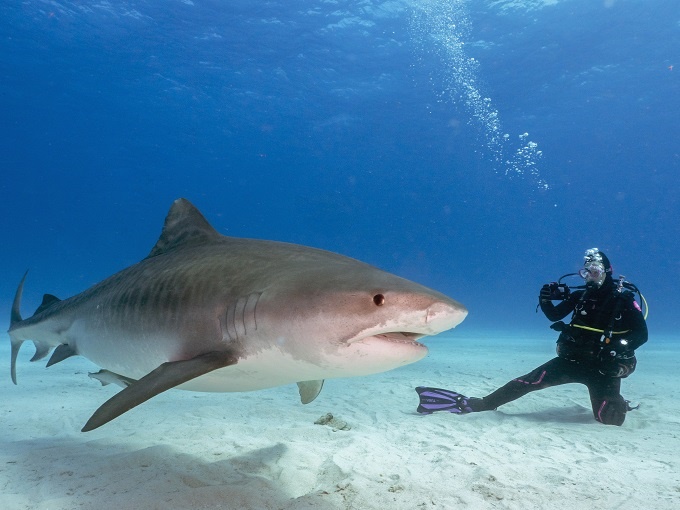 Karin Brussard • OM-D E-M1 MarkII • M.Zuiko Digital ED 12mm F2.0
Karin Brussard • OM-D E-M1 MarkII • M.Zuiko Digital ED 12mm F2.0
• PT-EP14 • PPO-EP02
Going overboard for the first time, your heart really is in your mouth. Standing on the afterdeck, we look at each other uncertainly; are we really going through with this? We count down and then jump into the water together, descending as quickly as possible via the line leading into the depths. Our instructions are to spend as little time as possible floating at the surface as that’s where we’re in the most danger. Tiger sharks always attack their prey from below and our shapes might confuse them into thinking we’re turtles breathing at the surface – not a mistake we want to happen. When we reach the bottom, the water is teeming with sharks. The reef sharks zoom around us, inspecting us with their tiny eyes, but that’s all. Lemon sharks may look very scary with their open mouths and crooked teeth, but this kind of shark is actually the most comfortable in our presence. Sometimes they even come and lie next to us to have a quick rest and you can also get really close to them if you keep calm. The tiger sharks are the most formidable sharks that we get to see. We received a comprehensive briefing before the first dive. Diving with sharks is not dangerous as long as you keep a few things in mind; after all, they are the major marine predators. So, the first rule is to spend as little time as possible floating at the surface. The second – and most important – is to always look tiger sharks in the eye. They attack their prey without being seen approaching, so the answer is very simple: make sure you watch them at all times. The arrangement is that the guides will warn us with an audible signal if a tiger shark is nearby. If any of the divers don’t see a tiger shark approaching, the signal will be given continuously and at a high speed. If we hear this signal, everyone has to look behind them. When there are just one or two tiger sharks, things are manageable, but at the peak time we have eight of them between four and six metres away from us at the same time. Because you’re focusing so much on your photos, there’s a strong risk that you won’t always spot a second and, possibly, a third shark approaching. If a curious tiger shark still comes too close, you can push it aside on top of its jaw. I’ve had to do this twice and, while it worked perfectly, it’s still a tense moment! But…. They truly are magnificent creatures. Every time one of them approaches me, I get so excited. For me, it’s one of the most enjoyable trips I’ve ever been on.
We’re standing on the afterdeck, kitted out in full diving gear, ready to jump overboard. Below us are around 30 Caribbean reef sharks and 10 lemon sharks, with indications that the first tiger sharks are also on their way. We look at each other indecisively; are we really going through with this? We count down: 3, 2, 1, GO, and we jump into the water, plunging between the sharks, straight to the bottom. We look around anxiously, nervous about what is going to happen. Everyone back at home has told us we’re mad. Diving with sharks? You’re risking your life!
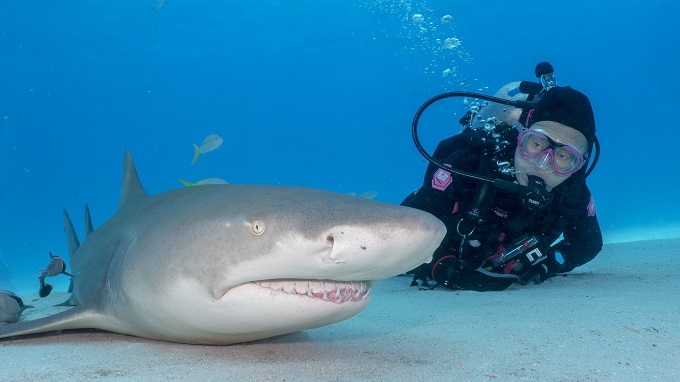
Karin Brussard • OM-D E-M1 MarkII • M.Zuiko Digital ED 12mm F2.0
• PT-EP14 • PPO-EP02
The aim of the trip is to find lemon sharks, reef sharks, tiger sharks and – with a bit of luck – dolphins and great hammerhead sharks. We’re spending five days diving three or four times a day off Tiger Beach, a sandbank no more than 15 metres deep to the north-west of the Grand Bahama island. Our boat is anchored there, trailing several crates containing fish remains. The currents carry the smell from the crates for huge distances, encouraging the sharks to converge on our location. This process – known as chumming – has been used here for many years and practically guarantees the presence of sharks. Twice a day, we get to watch while the sharks are fed underwater. I always used to be fiercely opposed to feeding because I thought it would influence how the sharks behave. After this trip, I’ve come to the conclusion that very little food is actually given; more like a dog getting a treat for coming when his master calls him. The sharks still have to hunt for their own food. So, do they behave differently around us here than elsewhere? Yes, absolutely! They approach us inquisitively to see if we have any treats for them. When they realise we don’t, they swim elegantly past us towards the next diver. I’ve now seen for myself that the way they behave doesn’t really change. So, is feeding them actually necessary? In this case, I think it is. It’s the only way to photograph these sharks and show the rest of the world what magnificent, beautiful creatures they are. And that’s what I want to achieve with my photos.
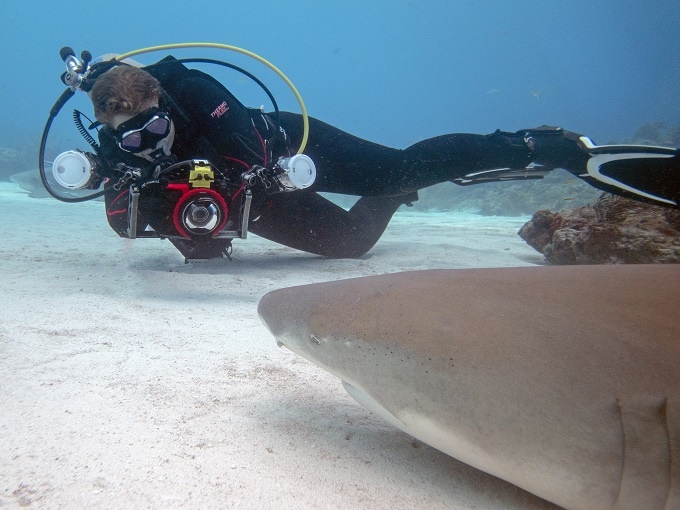 Karin Brussard • Tough TG-5 • PT-058
Karin Brussard • Tough TG-5 • PT-058
Going overboard for the first time, your heart really is in your mouth. Standing on the afterdeck, we look at each other uncertainly; are we really going through with this? We count down and then jump into the water together, descending as quickly as possible via the line leading into the depths. Our instructions are to spend as little time as possible floating at the surface as that’s where we’re in the most danger. Tiger sharks always attack their prey from below and our shapes might confuse them into thinking we’re turtles breathing at the surface – not a mistake we want to happen. When we reach the bottom, the water is teeming with sharks. The reef sharks zoom around us, inspecting us with their tiny eyes, but that’s all. Lemon sharks may look very scary with their open mouths and crooked teeth, but this kind of shark is actually the most comfortable in our presence. Sometimes they even come and lie next to us to have a quick rest and you can also get really close to them if you keep calm. The tiger sharks are the most formidable sharks that we get to see. We received a comprehensive briefing before the first dive. Diving with sharks is not dangerous as long as you keep a few things in mind; after all, they are the major marine predators. So, the first rule is to spend as little time as possible floating at the surface. The second – and most important – is to always look tiger sharks in the eye. They attack their prey without being seen approaching, so the answer is very simple: make sure you watch them at all times. The arrangement is that the guides will warn us with an audible signal if a tiger shark is nearby. If any of the divers don’t see a tiger shark approaching, the signal will be given continuously and at a high speed. If we hear this signal, everyone has to look behind them. When there are just one or two tiger sharks, things are manageable, but at the peak time we have eight of them between four and six metres away from us at the same time. Because you’re focusing so much on your photos, there’s a strong risk that you won’t always spot a second and, possibly, a third shark approaching. If a curious tiger shark still comes too close, you can push it aside on top of its jaw. I’ve had to do this twice and, while it worked perfectly, it’s still a tense moment! But…. They truly are magnificent creatures. Every time one of them approaches me, I get so excited. For me, it’s one of the most enjoyable trips I’ve ever been on.
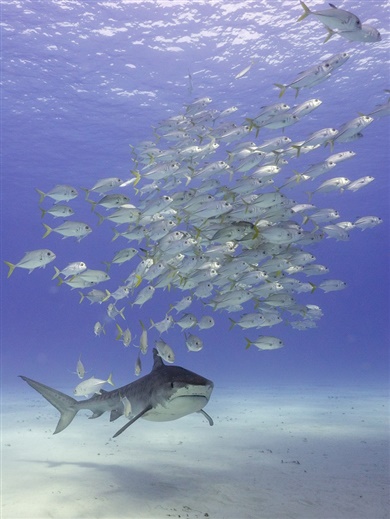
Karin Brussard • OM-D E-M1 MarkII • M.Zuiko Digital ED 12mm F2.0
• PT-EP14 • PPO-EP02
Comments
Show more comments (7)